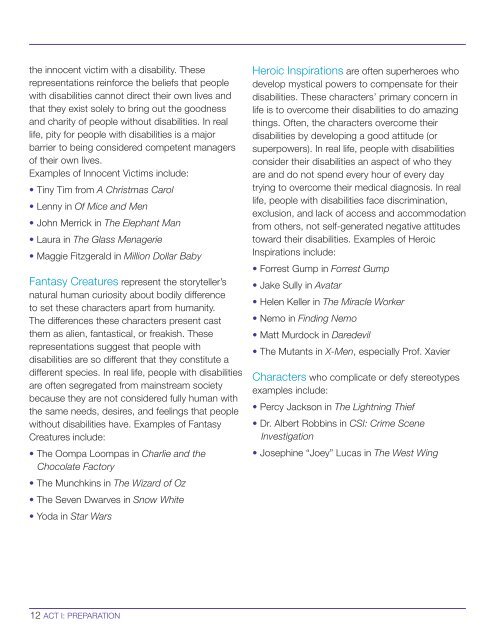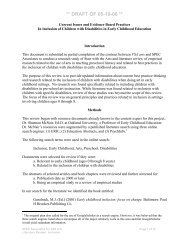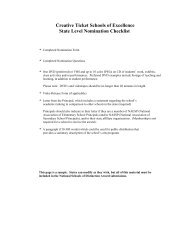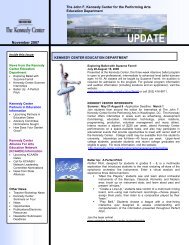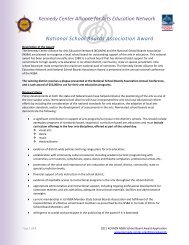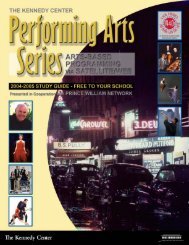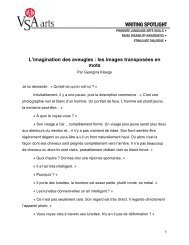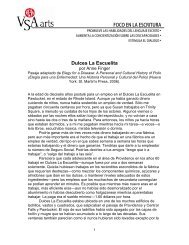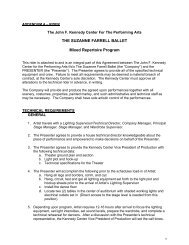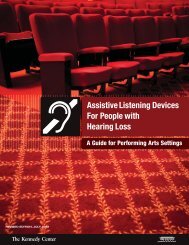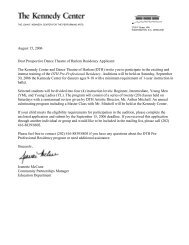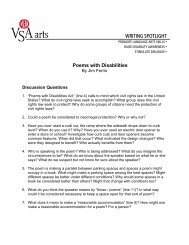Playwright Discovery Award Teacher's Guide - The John F. Kennedy ...
Playwright Discovery Award Teacher's Guide - The John F. Kennedy ...
Playwright Discovery Award Teacher's Guide - The John F. Kennedy ...
Create successful ePaper yourself
Turn your PDF publications into a flip-book with our unique Google optimized e-Paper software.
the innocent victim with a disability. <strong>The</strong>se<br />
representations reinforce the beliefs that people<br />
with disabilities cannot direct their own lives and<br />
that they exist solely to bring out the goodness<br />
and charity of people without disabilities. In real<br />
life, pity for people with disabilities is a major<br />
barrier to being considered competent managers<br />
of their own lives.<br />
Examples of Innocent Victims include:<br />
• Tiny Tim from A Christmas Carol<br />
• Lenny in Of Mice and Men<br />
• <strong>John</strong> Merrick in <strong>The</strong> Elephant Man<br />
• Laura in <strong>The</strong> Glass Menagerie<br />
• Maggie Fitzgerald in Million Dollar Baby<br />
Fantasy Creatures represent the storyteller’s<br />
natural human curiosity about bodily difference<br />
to set these characters apart from humanity.<br />
<strong>The</strong> differences these characters present cast<br />
them as alien, fantastical, or freakish. <strong>The</strong>se<br />
representations suggest that people with<br />
disabilities are so different that they constitute a<br />
different species. In real life, people with disabilities<br />
are often segregated from mainstream society<br />
because they are not considered fully human with<br />
the same needs, desires, and feelings that people<br />
without disabilities have. Examples of Fantasy<br />
Creatures include:<br />
• <strong>The</strong> Oompa Loompas in Charlie and the<br />
Chocolate Factory<br />
• <strong>The</strong> Munchkins in <strong>The</strong> Wizard of Oz<br />
• <strong>The</strong> Seven Dwarves in Snow White<br />
• Yoda in Star Wars<br />
Heroic Inspirations are often superheroes who<br />
develop mystical powers to compensate for their<br />
disabilities. <strong>The</strong>se characters’ primary concern in<br />
life is to overcome their disabilities to do amazing<br />
things. Often, the characters overcome their<br />
disabilities by developing a good attitude (or<br />
superpowers). In real life, people with disabilities<br />
consider their disabilities an aspect of who they<br />
are and do not spend every hour of every day<br />
trying to overcome their medical diagnosis. In real<br />
life, people with disabilities face discrimination,<br />
exclusion, and lack of access and accommodation<br />
from others, not self-generated negative attitudes<br />
toward their disabilities. Examples of Heroic<br />
Inspirations include:<br />
• Forrest Gump in Forrest Gump<br />
• Jake Sully in Avatar<br />
• Helen Keller in <strong>The</strong> Miracle Worker<br />
• Nemo in Finding Nemo<br />
• Matt Murdock in Daredevil<br />
• <strong>The</strong> Mutants in X-Men, especially Prof. Xavier<br />
Characters who complicate or defy stereotypes<br />
examples include:<br />
• Percy Jackson in <strong>The</strong> Lightning Thief<br />
• Dr. Albert Robbins in CSI: Crime Scene<br />
Investigation<br />
• Josephine “Joey” Lucas in <strong>The</strong> West Wing<br />
12 ACT I: PREPARATION


